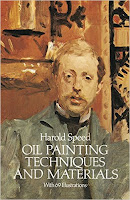 Welcome to the GJ Book Club. Today we'll cover pages 217-227 of the chapter on "Materials," from Harold Speed's 1924 art instruction book Oil Painting Techniques and Materials
Welcome to the GJ Book Club. Today we'll cover pages 217-227 of the chapter on "Materials," from Harold Speed's 1924 art instruction book Oil Painting Techniques and MaterialsI'll present Speed's main points in boldface type either verbatim or paraphrased, followed by my comments. If you want to add a comment, please use the numbered points to refer to the relevant section of the chapter.
1. Oil is a more challenging medium than watercolor because it often tends toward muddiness and it doesn't lend itself to accidental effects.
Another way to say it is that in inexperienced hands, it's easier to get an awful painting in oil, but harder to get a great painting in watercolor.
 |
| Oil painting by G. Hayes before and after cleaning (and maybe some Photoshop) from Oil Painting Restoration blog |
How about aerosol spray cans, silk screen, and house paint? It's as if Speed got his wish. Oil paints are expensive, slow to apply, slow drying, and comparatively dull, so it's no wonder that modern painters adopted other methods.
He says we can learn something from house painters, who in Speed's day would still mix their own paints. By mixing your own paints, you can control all the variables of the paint mixture
.jpg) |
| House painter circa 1915-1920 |
Sharp means 'mixed largely with turpentine which leaves a dull surface with a good tooth to take the final coat; this final coat being mixed with more oil or varnish.'
5. Painting material books that Speed recommends:
He notes that the early tempera pictures of the Italian school haven't darkened. Therefore, Speed recommends using as little oil or varnish as possible.
7. Linseed oil.
Regular state is a good drier; boiled linseed oil is a quicker dryer. Don't use too much or the surface may wrinkle in time.
Regular state is a good drier; boiled linseed oil is a quicker dryer. Don't use too much or the surface may wrinkle in time.
8. Poppy oil.
Lighter than linseed, doesn't darken as much. Slower dryer
9. Turpentine spirit.
Lighter than linseed, doesn't darken as much. Slower dryer
9. Turpentine spirit.
Test gum turpentine for purity by letting some dry off a white rag to see if it leaves a residue. He discusses how turpentine may be a factor in paint becoming more transparent over time.
10. Petroleum spirit.
Used in mixtures for oiling out. Use as little oil as possible when applying oil to freshen surface.
11. Copal, mastic, and amber varnish.
He says copal and amber are harder, used as painting mediums. "Picture copal" should be used only for a finish varnish. Mediums often include equal mixtures of oil and turps, or oil, varnish and turps.
12. Mastic varnish used in Speed's day for a finish varnish.
Speed recommends not varnishing unless you need to. As long as the painting doesn't depend on a lot of rich darks colors, relatively matte surfaces can show the colors better and be less subject to yellowing and darkening.
 Next week—We'll continue with pigments on page 227.
Next week—We'll continue with pigments on page 227.
GurneyJourney YouTube channel
My Public Facebook page
GurneyJourney on Pinterest
JamesGurneyArt on Instagram
@GurneyJourney on Twitter
10. Petroleum spirit.
Used in mixtures for oiling out. Use as little oil as possible when applying oil to freshen surface.
11. Copal, mastic, and amber varnish.
He says copal and amber are harder, used as painting mediums. "Picture copal" should be used only for a finish varnish. Mediums often include equal mixtures of oil and turps, or oil, varnish and turps.
12. Mastic varnish used in Speed's day for a finish varnish.
Speed recommends not varnishing unless you need to. As long as the painting doesn't depend on a lot of rich darks colors, relatively matte surfaces can show the colors better and be less subject to yellowing and darkening.
 Next week—We'll continue with pigments on page 227.
Next week—We'll continue with pigments on page 227.
-----
In its original edition, the book is called "The Science and Practice of Oil Painting ." Unfortunately it's not available in a free edition, but there's an inexpensive print edition that Dover publishes under a different title "Oil Painting Techniques and Materials
." Unfortunately it's not available in a free edition, but there's an inexpensive print edition that Dover publishes under a different title "Oil Painting Techniques and Materials (with a Sargent cover)," and there's also a Kindle edition.
(with a Sargent cover)," and there's also a Kindle edition.
----GurneyJourney YouTube channel
My Public Facebook page
GurneyJourney on Pinterest
JamesGurneyArt on Instagram
@GurneyJourney on Twitter







7 comments:
1. I agree with your assessment, based on my very scant knowledge. I did watercolors in high school and found them very demanding in terms of getting a good, clean painting without white space or messy bleeds. I recently painted my first oil painting (took a night class at Munson Williams Proctor) and instantly fell in love with the medium. People say it's easy to make muddy, but I found it great for making rich and vibrant colors (more on that below). I don't know if others were overworking the canvas or leaning on neutrals for value shifting.
3. Having most of my experience over the last few years in painting miniatures (little people, not tiny paintings), I learned using premixes and had little experience in how to control my paint. The single greatest thing I learned during my oils class was mixing from primaries. Of course, my effort is very primitive, but it is so freeing and empowering (and frustrating as a newbie) to be able to take garish bright colors and make a nice flesh tone, for instance. I'd spend over an hour mixing in the first few classes, and could mix a decent palette in less than a half hour by the last class. The pressure of a 3 hour class where mixing time is wasting good live model time was an intense learning experience I highly recommend for slow artists like myself :)
Here's my first attempt at oils. As I said, love the medium!
https://cashwiley.com/2016/04/15/thursday-night-oils-6/
When the instructor went over value placement, I knew a lot of the material (at a conceptual level, anyway!) thanks to the seminal book Color & Light. I recommended it to several students who were struggling with the lights and shadows. Most of the miniature painters have it on their shelf. I've thanked you before, James, but I do so again, because the book continues to be an indispensable reference. I hope to do it justice some day!
Thanks James for going through Speed's old text. I love reading your blog posts about technique and process.
I'm aware that you work in oils primarily for your finished illustration technique, as well as a few other artists that I admire like Donato Giancola, Greg Manchess, and Dan Dos Santos. I've never been the strongest painter and prefer drawing most of the time. I've fallen into the rut of using the method developed by Drew Struzan because of the fact that it is mostly drawing and very little painting. I feel that my artwork is lacking that originality though and just looks like a knock off of Drew's style, no matter how much I enjoy it while I'm actually creating the piece.
I have begun to practice painting more to get away from this rut and have really taken to gouache. I love it's ability to be mixed easily with other media, especially colored pencil. I've watched all of your gouache videos as well as "Gouache in the Wild" and have begun to really get comfortable with it.
My question is do you think gouache is a viable medium to create competitive and beautiful illustrations for the market that you and these other artists are in? Or is it more of just a good practicing medium? I've seen some of your posts about professionals who use gouache but for some reason you don't see many illustrators using it as a final medium anymore.
Thanks for all your posts and your insight.
Best.
Sean, gouache is definitely a great medium for final illustrations, and it was the standard for most of the '40s, '50s, and '60s, especially for architectural illustration, fashion art, and automotive ads. It has always been a go-to medium for natural science illustration, and it's making a big comeback across the board now because of its suitability to sketchbooks, its easy handling, and quick drying, and the fact that it dries matte, which makes it photograph well. Oils' big advantage is the ability to control drying time and therefore, to make it easier to achieve soft edges and out of focus effects.
Cashwiley, those sound like great experiments. Thanks for recommending Color and Light. I really appreciate it.
James, I’ve never heard a better description of the challenges between oil and watercolor than your comment: "... in inexperienced hands, it's easier to get an awful painting in oil, but harder to get a great painting in watercolor.” Based on my humble experience I couldn’t agree more. Thank you for sharing your insight and offering such intriguing subjects for discussion.
Oil painting mediums, and for that matter oil paints, is one of those things that is hardest to nail down or figure out conclusively. It can be difficult to decipher from all the information out there what is true regarding longevity, what materials or methods to use, what is archivally safe etc.
Maybe its just me but often I come away more perplexed about which medium to use if any, what ground is safest, paint support, technique... even varnishing.
Of course a lot of that has to do with changing technology, chemical make up(s) of modern paints and mediums, supports compared to 100 years ago, even 20 or 30 years ago and we can't expect modern ones to be the equivalent to olds ones for better or worse.
I agree with Fred on your description of the challenges between oil and watercolor. So true!
Sean—
By Drew Struzan's technique, I assume you are referring to his method of combining acrylics and colored pencil. It is a great combination for illustration and was used by many excellent artists with different styles. Richard Amsel is an illustrator who worked with a technique very similar to Struzan.
I can understand a person wanting to explore other media, especially for fine art. Personally, I feel that artists are usually at their best when working in ways that are natural to them. Don't discount the power of drawing as a medium in itself or techniques that employ drawing with other media. As an illustrations, Paul Calle's pencil work is hard to beat—even now years later.
I like the joke Struzan told of a studio producer who wanted Amsel to do the poster illustrations for a new movie. His assistant told him, "Amsel is dead." The producer said, "Well, offer him more money!"
If you can pull off a Struzan or an Amsel, you must be doing good work.
Thank you James and Paul. I'm glad to hear that gouache is a good medium to finish with. I'm just going to keep practicing. And yes Paul, I was speaking of the acrylic/colored pencil technique. I really enjoy that technique but the way I do it looks very like Struzan's style. If you go to my Facebook page you can see a self portrait I just finished as an example of the technique.
https://www.facebook.com/Sean-Usyks-Illustration-150353788361080/
I'm working on a piece right now that I'm attempting to use James's process shown in his "How I Paint Dinosaurs" video but finishing with gouache and colored pencil instead of oil. I'll let everyone know when it is done and see if you guys have any feedback or comments. Thanks again!
Post a Comment